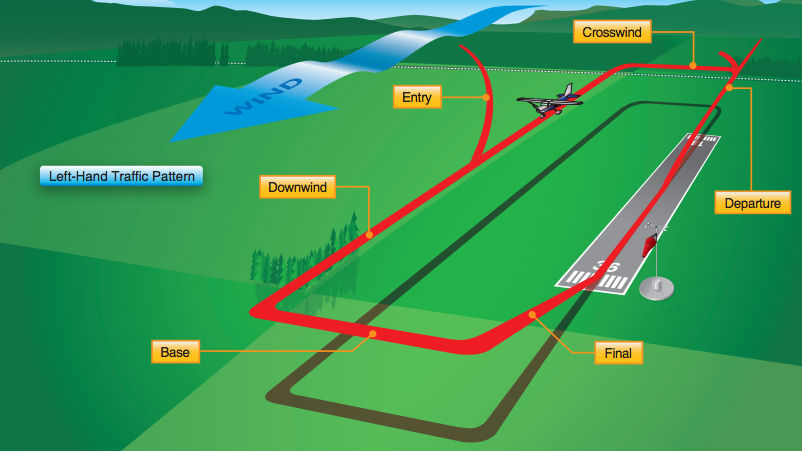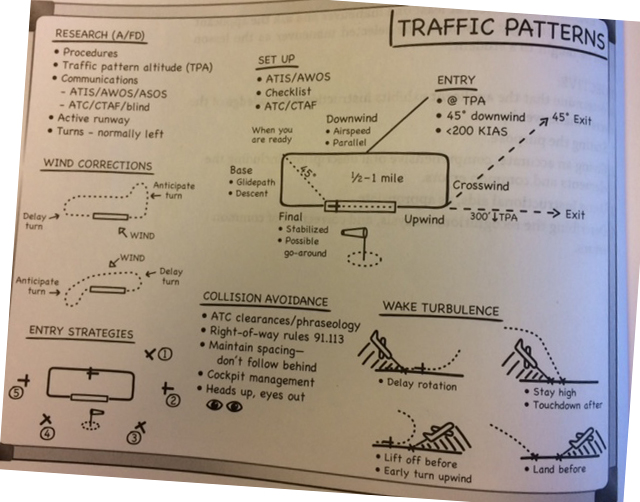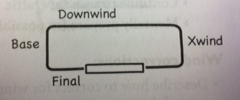Traffic Patterns
September 13, 2018
The traffic pattern is a standardized rectangle around the runway. It provides an orderly flown of the traffic for aircraft arriving, departing and operating in the vicinity of an airport at the same time, the traffic pattern provides a flow of cockpit tasks the pilot must complete in preparation for takeoff and/or landing.
This material comes from: Lesson Plans – To Train Like You Fly – A flight Instructor’s Reference for Scenario-Based Training
Suggested Materials: Whiteboard and Markers, POH, A/FD, and AC90-66
Introduction:
Spend at least three minutes introducing the maneuver to the student. Describe the situations that are motivation for learning it. as well as objectives to strive for.
Motivation:
The traffic pattern is a standardized rectangle around the runway. It provides an orderly flown of the traffic for aircraft arriving, departing and operating in the vicinity of an airport at the same time, the traffic pattern provides a flow of cockpit tasks the pilot must complete in preparation for takeoff and/or landing.
Objective:
In this lesson you learn the correct procedures to arrive at, depart from or operate around an airport.
Elements of the Maneuver:
First a look at the universal elements of the maneuver – elements that are not aircraft specific.
Pattern Leg Names:
- downwind
- base
- final
- crosswind
Takeoff begins before leaving the dispatch area. the first thing a pilot dose in preparation for takeoff is research:
- Research in A/FD
- Some airports have special procedures including noise abatement or obstacle clearance
- Traffic pattern altitude – what it is, why it’s important; in the A/F/D or 1,000 ft AGL.
- Who will you communicate with –
- AWOS/ATIS/ASOS (for the latest information about the airport).
- ATC/CTAF/into the blind (who you might talk to, around the airport).
- Identify notable obstacles and wires, and the procedures to avoid them.
- The active runway should be the one most aligned with the wind.
- turns are normally to the left.
- major runway markings and lighting.
Add the cockpit tasks and aircraft configuration changes to complete along each leg:
- Set up – about 10 miles outside a non-towered field. At a controlled filed it depends on the airspace.
- Listen to ATIS/AWOS.
- Aircraft pre-landing checklists
- Communicate with ATC/CTAF
- Downwind – Primary objective on downwind is to stabilize the airspeed. Starting abeam the touchdown point.
- slow to approach speed and stabilize.
- Maintain wind correction to fly and remain parallel to runway
- Maintain traffic pattern altitude don’t begin a descent while flying away from the runway
- Turn base only when you are ready. If you begin abeam the touchdown point, you should be 45 degrees (however, this may change).
- Continue to scan for traffic
- On base- the objective on base is to stabilize the glide path:
- Reduce power to achieve a speed of about 1.4 Vso
- Begin stabilized descent.
- Continue to scan for traffic
- Final – the objective on final approach is to make only small coreections as necessary:
- Reduced power to achived a spead of about 1.3Vso
- Maintain a stablized approach speed and glide path
- Continue to scan for traffic.
- Mentally prepare for a possible go-around.
Wind corrections:
- Describe how to correct for wind drift to maintain the proper ground track on each leg.
- Anticipate the turn to final
Proper entry:
- Be at traffic pattern altitude before entering traffic pattern.
- On downwind leg, at a 45 degree angle abeam the midpoint of the runway.
- Less than 200KIAS
Discuss entry strategies from different areas around the airport:
- Aircraft/runway diagram showing numbers 1-5
- Diagram is not meant to indicate proximity to runway; rather, the general direction they are coming from (due to limited board space)
Departing the traffic pattern:
- Straight out
- 45 degree left turn off runway heading after reaching traffic pattern altitude
Collision avoidance:
- Controlled Fields – ATC clearances,
- If you accept it, you must comply with it – or have it amended.
- You don’t have to accept it; you are pilot in command
- Use proper phraseology.
- Right of Way rules (14 CFR 91.113) apply – but, if needed for safety be willing to give up your right of way.
- Maintain proper spacing from other traffic –
- Slow to approach speed or slower.
- Widen traffic pattern.
- Don’t follow directly behind another plane. Fly 30 to 40 degrees outside of the other aircraft’s traffic pattern.
- S-Turns are not recommended on short/low final.
- Go-Around
- Good cockpit management needed to keep your head up and looking around.
- Operations differ at airports without an operating control tower.
- An organized cockpit means less time with your head down.
Wake turbulence avoidance is an emphasis area for operations in the traffic pattern:
- Explain avoidance in
- Taking off after larger planes landing
- taking off large planes taking off
- landing after larger plane landing
- landing after larger plane taking off
Performance

